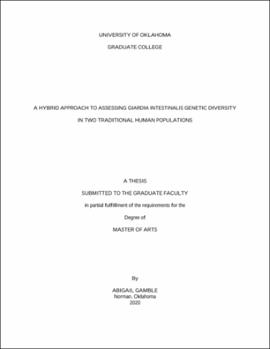| dc.contributor.advisor | Lewis, Cecil M. Jr. | |
| dc.contributor.author | Gamble, Abigail | |
| dc.date.accessioned | 2020-05-08T21:48:47Z | |
| dc.date.available | 2020-05-08T21:48:47Z | |
| dc.date.issued | 2020-05-08 | |
| dc.identifier.uri | https://hdl.handle.net/11244/324355 | |
| dc.description.abstract | The protozoan parasite Giardia intestinalis is traditionally viewed as a harmful agent of diarrheal disease in humans, and is the target of prevention and treatment efforts around the world. However, most cases of G. intestinalis are asymptomatic, and prevalence rates of greater than 80% in several human populations without adverse effects raise the possibility that this microeukaryote could be a commensal member of the human gut microbiome. The Giardia intestinalis species has been divided into eight genetic assemblages, and some research suggests particular assemblages may be more pathogenic than others. In addition, research into the presence and assemblage diversity of G. intestinalis in traditional and hunter-gatherer societies can provide insight on the conditions under which this microeukaryote may be commensal in humans, as the gut microbiomes of these individuals have not been affected by industrialized practices that have historically depleted microbial diversity in the human gut.
This thesis addresses this relatively underexplored area of research by attempting to determine the G. intestinalis assemblages present in asymptomatic hunter-gatherers from Peru and individuals from a traditional community of Burkina Faso. A hybrid approach consisting of targeted amplification of the glutamate dehydrogenase (gdh) gene and next-generation sequencing using the Illumina MiSeq was developed, and the presence of G. intestinalis was confirmed in the hunter-gatherer population of Peru. While poor data quality and probable database bias precluded a confident declaration of the assemblage, we may have identified a novel subassemblage of Giardia intestinalis in one individual from the Peruvian Amazon. This suggests that hunter-gatherer populations may harbor a greater diversity of assemblages in a commensal state. | en_US |
| dc.language | en_US | en_US |
| dc.rights | Attribution-NonCommercial-NoDerivatives 4.0 International | * |
| dc.rights.uri | https://creativecommons.org/licenses/by-nc-nd/4.0/ | * |
| dc.subject | Traditional populations | en_US |
| dc.subject | Human gut microbiome | en_US |
| dc.subject | Parasites | en_US |
| dc.title | A Hybrid Approach to Assessing Giardia intestinalis Genetic Diversity in Two Traditional Human Populations | en_US |
| dc.contributor.committeeMember | Hofman, Courtney | |
| dc.contributor.committeeMember | Hirschfeld, Tassie | |
| dc.date.manuscript | 2020-05-05 | |
| dc.thesis.degree | Master of Arts | en_US |
| ou.group | College of Arts and Sciences::Department of Anthropology | en_US |
| shareok.orcid | https://orcid.org/0000-0001-5000-6249 | en_US |
| shareok.nativefileaccess | restricted | en_US |

